
Вы можете использовать современные методы анализа нержавеющей стали, такие как XRF, Эс, ААС, ICP-OES, XPS, магнит, визуальный, и химические спотовые тесты. Эти тесты помогут вам быстро и правильно проверить из нержавеющей стали. Они помогают вам проверить качество, безопасность, И если сплав настоящий. Люди проверяют нержавеющую сталь, чтобы убедиться, что она следует правилам и хорошо работает. Некоторые методы анализа нержавеющей стали, такие как Потенциодинамическая поляризация Дайте вам номера для коррозионной сопротивления. Использование правильных тестов может сделать инструменты в течение длительного времени 300% дольше. Всегда выбирайте лучший тест на то, что вам нужно.
Ключевые выводы
Используйте современные тесты из нержавеющей стали, такие как РФА, Эс, и химические испытания на пятно, чтобы быстро и правильно найти стальные оценки. Эти тесты помогают убедиться, что сталь хорошего качества.
Подготовить образцы, убирая и хорошо их полирует. Это поможет вам получить хорошие результаты теста и останавливает ошибки.
Руковочные инструменты, как Xrf -анализаторс Позвольте вам быстро проверить сталь в поле. Вы можете использовать их, не повредив металл.
Сравните результаты теста со стандартами и диаграммами. Это помогает вам узнать сталь и проверить, безопасно ли она, и сопротивляется ржавчине.
Всегда следуйте правилам безопасности при тестировании. Используйте более одного метода, чтобы проверить ваши результаты на предмет наилучшей точности и помочь вашему проекту добиться успеха.
Методы анализа нержавеющей стали
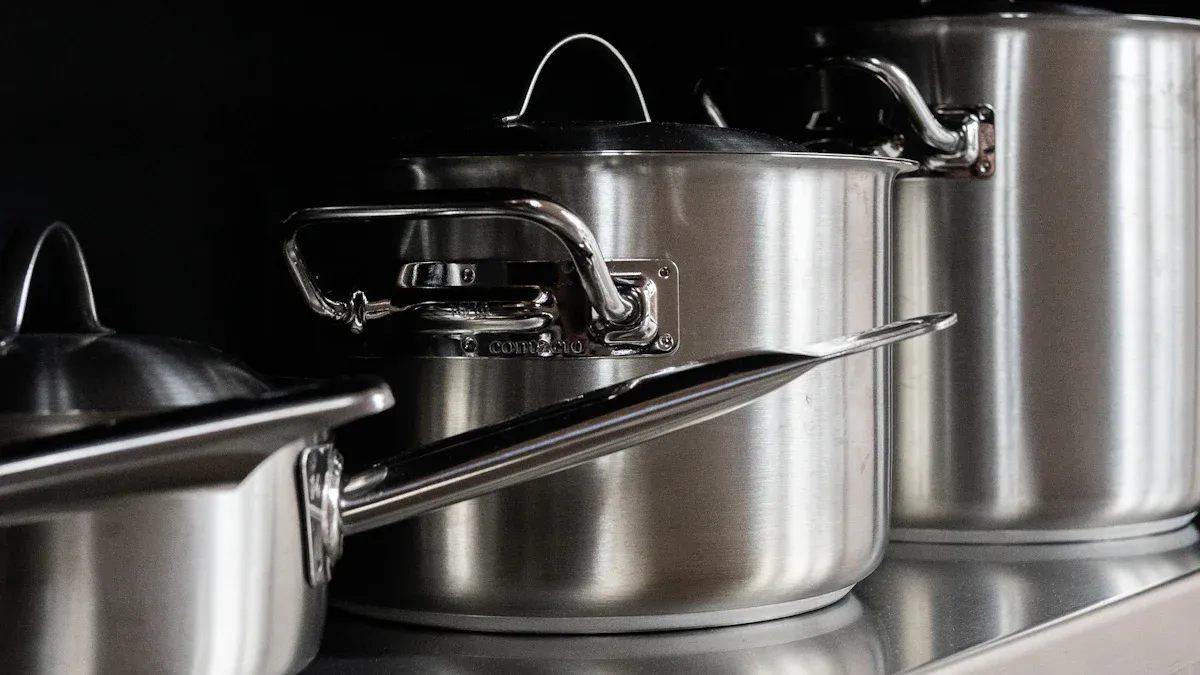
Современный анализ нержавеющей стали использует много способов тестирования. Каждый путь помогает вам быстро и правильно найти оценки. Некоторые тесты работают лучше всего за пределами лаборатории. Другим нужны специальные лабораторные инструменты. Выберите правильный тест для ваших нужд. Подумай о том, как быстро, как точно, и какие у вас есть инструменты.
Рентгенофлуоресцентные анализаторы
Xrf -анализаторы Используйте рентгеновскую флуоресценцию для проверки элементов в нержавеющей стали. Вы можете использовать Портативный Инструменты для быстрого, безопасное тестирование. Эти инструменты дают результаты в секундах. Они хорошо работают на заводах и складах.
Современные РФ-анализаторы, как ESI H-500, очень точные. Для нержавеющей стали 316, Результат хрома близок, о 0.2% выключенный. Для марганца, Это о 2.7% выключенный. Эти инструменты могут найти элементы из 1 к 500 ppm. Для нержавеющей стали 304, Точность для хрома, марганец, никель, медь, и молибден находится между 94.5% и 99.5%. Вы можете доверять этим инструментам для хорошего анализа нержавеющей стали. XRF лучше всего подходит для классов с большим количеством хрома и никеля, нравиться 304 и 316. Xrf не очень хорошо работает для световых элементов, таких как углерод.
Кончик: Используйте xrf -анализаторы, когда вам нужно быстро, точный, и безопасные результаты вне лаборатории.
OES и ICP-OES
EES и ICP-OES являются лабораторными тестами. Вы используете их, когда вам нужны очень точные результаты. EES использует искру, чтобы возбудить атомы в металле. ICP-OES использует плазму для этого.
ICP-OES находит крошечные количества элементов.
Это дает очень точные и правильные числа.
Этот тест следует строгим правилам и может найти 30 азы.
ICP-OES хорошо работает для твердых образцов и имеет большой ассортимент.
Использование ICP-OE в качественных проверках может сократить сбои на оборудование 70%.
ICP-OES встречает китайское правление ГБ/т 20125-2006 Для анализа нержавеющей стали. Используйте OE или ICP-OES, чтобы проверить крошечные примеси или когда вам нужны сертифицированные результаты. Эти тесты помогут вам найти оценки, как 304, 316, 321, и дуплексные нержавеющие стали.
ААС и XPS
AAS и XPS являются расширенными лабораторными тестами. Вы используете AAS для измерения определенных элементов, как никель или хром, с высокой точностью. AAS хорош для проверки небольшого количества элементов в нержавеющей стали.
XPS помогает вам изучить поверхность нержавеющей стали. Вы можете использовать XPS, чтобы посмотреть на тонкие покрытия или обработки поверхности. Этот тест дает вам подробности о химическом состоянии элементов на поверхности. Используйте XPS, когда вам нужно знать о поверхностном макияже или грязи.
Как AAS, так и XP нужны специальные инструменты и обученные работники. Вы используете эти тесты для исследования, качественные проверки, или когда вам нужен анализ глубокой нержавеющей стали.
Магнитные и визуальные тесты
Вы можете использовать магнит, чтобы быстро проверить оценки нержавеющей стали. Аустенитные оценки, нравиться 304 и 316, не магнитные. Ферритные и мартенситные оценки, нравиться 430 и 410, магнитные. Дуплексные оценки немного магнитные.
Семья классов из нержавеющей стали | Магнитный уровень ответа | Относительный диапазон проницаемости | Пример оценки |
|---|---|---|---|
Аустенитный | Немагнитный | 1.003 – 1.005 | 304, 316, 321 |
Ферритный | Сильно магнитный | 500 – 1000 | 430, 409, 439 |
Мартенсит | Сильно магнитный | N/a | 410, 420 |
Дуплекс | Умеренно магнитный | 20 – 100 | 2205, 2304 |
Вы также можете посмотреть на поверхность, чтобы проверить отделку и сиять. Обученные инспекторы могут разделиться друг от друга, семейные семейства классов из нержавеющей стали до 80% того времени. Магнит и визуальные тесты помогают с быстрыми первыми проверками. Всегда проверяйте результаты с другими методами анализа нержавеющей стали.
Испытания химических пятно и искры
Вы можете использовать кислотный тест, Химический точечный тест, и Spark Test for Fast, дешевые чеки. В тесте кислоты используются специальные химические вещества для реагирования с такими элементами, как молибден или никель. Химический тест может быть 95% правильный, Особенно для рассказа 304 от 316. Кислотный тест прост и хорош для быстрой проверки.
В тесте Spark используется шлифовальная мешка, чтобы сделать искры из металла. Вы смотрите на цвет и форму искры, чтобы рассказать. Испыл тест может быть 75% правильный. Вам нужно тренироваться, чтобы правильно прочитать искры.
Метод испытаний | Скорость успеха / Улучшение | Ключевые данные и точки проверки |
|---|---|---|
Искра на тестирование | До 75% точность | На основании 1,000 образцы; Хорошо, чтобы рассказать о главных семействах классов из нержавеющей стали; нуждается в обученных людях. |
Химическое точечное тестирование | Специальное обнаружение молибдена помогает сообщить о оценках, таких как 304 и 316; Быстрая первая проверка. | |
Улучшения протоколов | До 60% меньше времени, чтобы проверить | Стандартные шаги, такие как подготовка поверхности, контроль температуры, Проверенные химические вещества, и цифровые заметки делают тесты лучше и быстрее. |
Используйте кислотный тест, Химический точечный тест, и Spark Test для быстрой сортировки или когда у вас нет причудливых инструментов. Всегда проверяйте свои результаты с другими методами анализа из нержавеющей стали для важных заданий.
Как проверить нержавеющую сталь
Шаги подготовки
Перед тестированием нержавеющей стали, вам нужно подготовить образец. Хорошая подготовка помогает получить правильные результаты. Следуйте этим шагам:
Очистите металлическую поверхность мягкой тканью, чтобы удалить грязь и масла.
Используйте тонкую шлифовальную бумагу, чтобы сгладить область Вы хотите проверить. Избегайте грубого измельчения, который может изменить металл.
Отличить поверхность алмазной пастой или специальной ткани. Этот шаг удаляет царапины и делает поверхность блестящей.
Для некоторых тестов, Используйте химический трасса. Выберите правильный затрат для типа нержавеющей стали.
Высушите образец перед началом тестирования.
Кончик: Тщательная подготовка помогает вам избежать ошибок при тестировании нержавеющей стали.
Использование портативных устройств
Портативные устройства Сделайте легко проверять нержавеющую сталь в поле. Вы можете использовать такие инструменты, как анализаторы XRF или Libs. Эти устройства портативны и дают быстрые результаты.
Поместите устройство на чистую металлическую поверхность.
Нажмите кнопку или кнопку, чтобы запустить тест.
Подождите несколько секунд, пока устройство покажет результаты.
Прочитайте экран, чтобы увидеть оценку и элементы.
Показатель производительности | Значение/описание |
|---|---|
Вес устройства | |
Точность | Лабораторное качество в поле |
Углеродный диапазон | 100–300 ч / млн |
Портативность | Легко носить и использовать где угодно |
Управляющие устройства помогут протестировать из нержавеющей стали для контроля и сортировки качества. Вам не нужно приносить образцы в лабораторию.
Лабораторные испытания
Некоторые тесты нуждаются в специальном оборудовании и обученных работниках. В лаборатории, Вы можете использовать OES, ААС, или усовершенствованные тесты на коррозию. Например, а ASTM G48 Стандарт Использует хлорид железа для проверки коррозии с из нержавеющей стали в нержавеющей стали. Вы должны контролировать такие вещи, как ph, кислород, и поверхностная отделка. Ученые используют статистические модели для изучения глубины и размера ямы. Эти шаги помогут вам получить точные результаты при тестировании нержавеющей стали.
Советы по безопасности
Всегда оставайтесь в безопасности, когда вы тестируете из нержавеющей стали. Носите перчатки, очки, и лабораторный халат. Работать в хорошо проветриваемом районе, особенно при использовании кислот или шлифовальных машин. Держите химические вещества подальше от вашей кожи и глаз. Очистите разливы сразу. Никогда не ешьте и не пить возле испытательной зоны.
Заметка: Безопасность сохраняет здоровье и помогает получить наилучшие результаты каждый раз, когда вы тестируете из нержавеющей стали.
Проанализировать результаты нержавеющей стали
Чтение элементных данных
Когда вы проверяете нержавеющую сталь, Вы смотрите на числа для каждого элемента. Тесты показывают, сколько хром, никель, и молибден в металле. Эти цифры говорят вам, из чего сделан металл и как он будет действовать. Вы можете использовать эту таблицу, чтобы увидеть обычную сумму для каждого элемента:
Элемент | Массовый диапазон фракции (%) |
|---|---|
Хром | |
Кобальт | 0.05 к 0.45 |
Медь | 0.06 к 3.5 |
Марганец | 0.3 к 5.5 |
Молибден | 0.02 к 3.5 |
Никель | 0.6 к 35 |
Ниобий | 0.03 к 1.3 |
Фосфор | 0.01 к 0.03 |
Кремний | 0.1 к 2 |
Сера | 0.02 к 0.35 |
Титан | 0.008 к 0.5 |
Ванадий | 0.02 к 0.25 |
Вы также можете посмотреть на диаграмму ниже, чтобы сравнить, сколько из каждого элемента находится в нержавеющей стали:
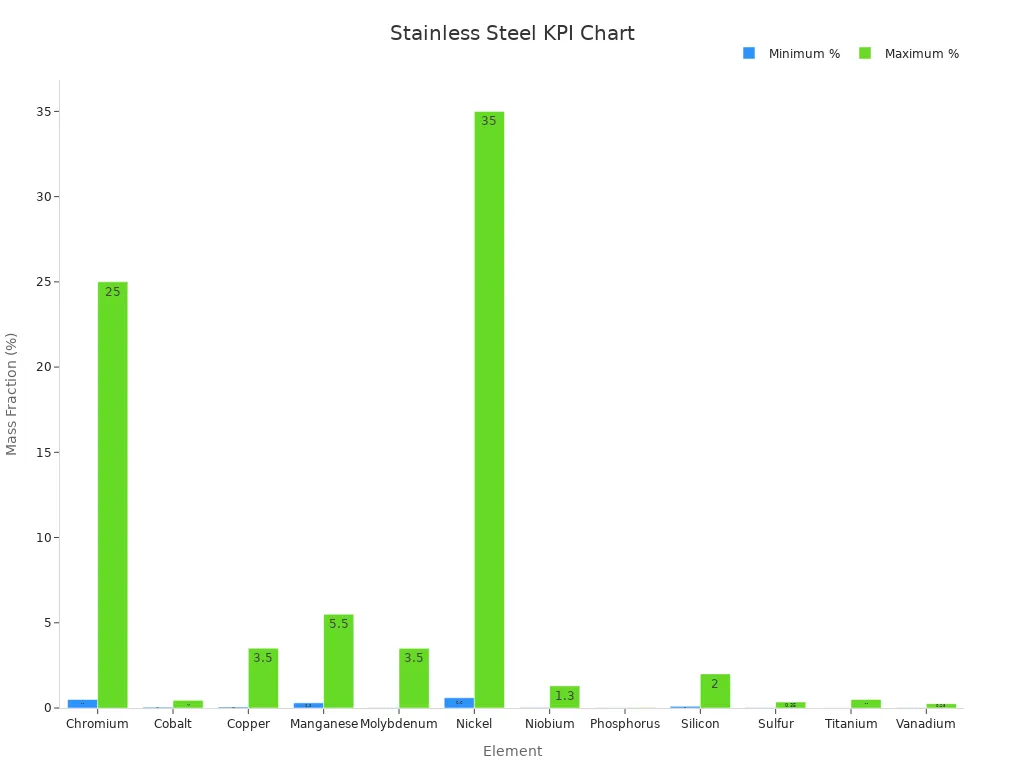
Кончик: Всегда ищите номер тепла в вашем образце. Этот номер помогает вам сопоставить результаты теста с правильной партией и проверить химический макияж.
Сопоставление с оценками
Вы можете выяснить оценку нержавеющей стали, сопоставив свои цифры с известными оценками. Например, Если вы видите о 18% Хром и 10% никель, у тебя, вероятно, есть 304 нержавеющая сталь. Если молибден закончился 2%, это может быть 316, Что борется с ржавкой лучше. Используйте стандартные диаграммы, чтобы сравнить ваши результаты. Этот шаг помогает вам выяснить, какой у вас оценка и что он соответствует правилам.
Количество углерода, кремний, хром, марганец, медь, и молибден поможет вам выбрать оценку.
Тесты HHXRF и HHLIBS могут быстро сообщить о оценках, подобных 303 и 304 отдельно.
LIBS может измерять очень небольшие количества углерода, даже до 0.03%, что важно для оценки L и H.
Если вы используете результаты теста с Данные коррозии, Вы получаете полное представление о том, насколько сильна и жестко металл.
Стандарты и спецификации
Вы должны проверить свои результаты по мировым стандартам, чтобы убедиться, что ваша нержавеющая сталь достаточно хороша. Эти правила перечисляют, какие элементы и сильные стороны должны иметь каждый класс. Вот несколько важных Стандарты ASTM:
ASTM Стандарт | Поддержка с охватом и элементарным анализом |
|---|---|
ASTM A269 | Проверяет бесшовные и сварные аустенитные трубки из нержавеющей стали на сопротивление ржавчины и химического макияжа. |
ASTM A213 | Смотрит на бесшовные ферритные и аустенитные трубки сплавкой сплав; Включает тесты ржавчины и прочности. |
ASTM A249 | Тесты сварки аустенитных стальных труб; нуждаются в химических и ржавчинских проверках. |
ASTM A908 | Управляющие аустенитными игольчами из нержавеющей стали; Проверяет правила химического и прочности. |
Заметка: Следование этим правилам помогает вам убедиться, что ваша нержавеющая сталь безопасна, сильный, и сопротивляется ржавчине в ваших проектах.
Расширенные методы идентификации нержавеющей стали
Профилирование глубины
Иногда вам нужно знать, насколько глубоко уходит покрытие. Профилирование глубины поможет вам увидеть слои под поверхностью. Профилирование глубины нейтронов (НДП) может измерять световые элементы в покрытиях. НДП не повреждает ваш образец. НДП работает в высоком вакууме. Он может найти очень крошечное количество элементов, даже маленький как 1E+12 атомов на квадратный сантиметр. Этот метод показывает, насколько толстым является покрытие и где каждый элемент. Вторичная ионная масс -спектрометрия (Симс) это еще один способ проверить. SIMS может измерять элементы на уровне нанометра. Это показывает, как элементы меняются, когда вы идете глубже. Эти лабораторные тесты помогают вам увидеть, является ли покрытие равномерным и удовлетворяет ваши потребности.
НДП хорош для проверки тонких покрытий.
SIMS дает вам очень подробные результаты глубины.
Оба метода помогают вам узнать о слоях под поверхностью.
Поверхностный анализ
Анализ поверхности позволяет увидеть, что находится на вершине нержавеющей стали. Рентгеновская фотоэлектронная спектроскопия (XPS) часто используется для этого. XPS помогает выяснить, какие элементы на поверхности. Это также показывает, какие химические состояния у них есть. Например, после Плазменная очистка, XPS может показать изменения в углероде, кислород, железо, и хром. Испытания на угла контакта с водой тоже помогают. Если вы относитесь к поверхности, Угол становится меньше. Это означает, что поверхность легче намочить, и лучше связывается. Другие методы лечения, как окисление микроарка, Сделайте поверхность грубой и полной отверстий. Вы можете увидеть эти изменения со специальными микроскопами. Эти тесты помогут вам проверить, работает ли ваша поверхность.
Когда использовать расширенные методы
Использовать Усовершенствованная идентификация нержавеющей стали Когда вам нужно больше деталей, чем базовые тесты дают. Если вы хотите изучать покрытия, поверхностная обработка, или сложная коррозия, Используйте эти методы. Модели машинного обучения Можно догадаться, как будет действовать нержавеющая сталь во время холодного формирования. Эти модели помогут вам выбрать правильный материал и сэкономить деньги. Генетические алгоритмы Сделайте тесты на специальные стали точнее. Когда вам нужно сказать небольшие различия в коррозии или изменениях поверхности, продвинутые методы работают лучше. Вы можете использовать результаты, такие как точность и точность Чтобы увидеть, нужны ли вам эти тесты. Расширенные методы помогут вам решить жесткие проблемы, которые простые тесты не могут исправить.
Таблица сравнения методов
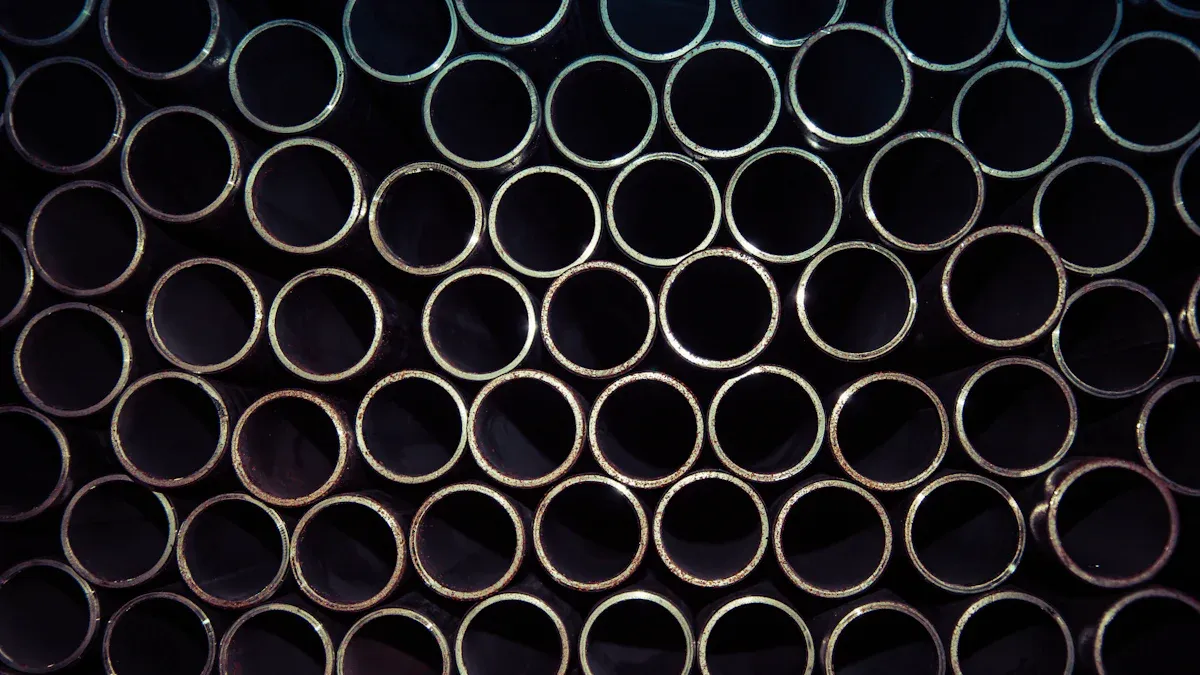
Сводная таблица
Вы можете использовать эту таблицу для сравнения основных методов анализа нержавеющей стали. Он показывает, как работает каждый метод, где вы можете его использовать, и что лучше для. Это поможет вам выбрать правильный тест на ваши потребности.
Метод | Скорость | Точность | Полевое использование | Лабораторное использование | Обнаружены элементы | Лучше всего подходит для |
|---|---|---|---|---|---|---|
Секунды | Высокий | Да | Да | Большинство металлов (не c) | Быстрая сортировка, идентификатор класса | |
Эс | Минуты | Очень высоко | Нет | Да | Большинство металлов (внедорожник. В) | Полная оценка чека, следы |
ICP-OES | Минуты | Очень высоко | Нет | Да | Над 30 азы | Проверка нечистота, Лабораторный анализ |
ААС | Минуты | Высокий | Нет | Да | Выберите элементы | Никель, хром, Следы металлов |
XPS | Часы | Очень высоко | Нет | Да | Поверхностные элементы | Покрытия, поверхностная обработка |
Магнитный тест | Секунды | Умеренный | Да | Да | Магнитный ответ | Быстрый семейный чек |
Визуальный тест | Секунды | Умеренный | Да | Да | Поверхностные особенности | Первый взгляд, Завершить чек |
Spot/Spark Test | Секунды | Умеренный | Да | Да | Ключевые элементы | Быстрая сортировка, базовый идентификатор |
Кончик: Используйте эту таблицу, когда вы хотите сравнить скорость, точность, и где вы можете использовать каждый тест.
Выбор правильного метода
Вам нужно выбрать лучший тест для вашей работы. Подумайте о том, что вы хотите узнать и где вы будете работать. Если вам нужно знать точные элементы в вашей стали, Используйте химический анализ, такой как XRF или OES. Эти тесты помогут вам выбрать правильный класс для коррозионной сопротивления и прочности. Если вы хотите проверить, насколько сильна ваша сталь, Используйте тестирование на растяжение или твердость. Эти тесты показывают, может ли ваша сталь обращаться с тяжелыми нагрузками или износом.
Используйте стандарты ASTM, чтобы убедиться, что ваши результаты теста надежны.
Посмотрите на лабораторные отчеты, чтобы получить такие цифры, как сила урожая и твердость. Эти цифры помогают вам решить, безопасна ли ваша сталь в использовании.
Модели машинного обучения могут помочь вам предсказать, как ваша сталь отреагирует в разных средах. Эти модели используют данные из вашего теста, чтобы угадать коррозионное поведение. Вы можете сэкономить время и деньги, используя эти инструменты вместо проведения многих тестов.
Если вам нужно проверить покрытие или обработку поверхности, Выберите XPS или профилирование глубины. Эти тесты показывают, что на поверхности и насколько глубоко она идет.
Помнить: Хорошее тестирование помогает вам избежать сбоя продукта и обеспечивает безопасность ваших проектов.
У вас есть много способов протестировать нержавеющую сталь. РФА и OE дают вам быстрые и точные результаты для большинства оценок. Использовать XPS или SEM Когда вам нужно проверить изменения поверхности или коррозию. Всегда сопоставляйте свой метод с вашей работой. Тестирование помогает вам заметить коррозию рано и сохранить свои проекты в безопасности.
Очистите образцы и выполните шаги безопасности каждый раз.
Запишите результаты для отслеживания коррозии и изменений материала.
Хорошее тестирование и тщательные записи помогут вам предотвратить коррозию и улучшить вашу работу.
Вопросы и ответы
Как вы можете определить, если нержавеющая сталь 304 или 316?
Вы можете использовать химический тест на точечный тест, чтобы проверить на молибден. Оценка 316 имеет молибден, но 304 нет. Xrf -анализаторы Также помогите вам увидеть разницу, показывая суммы элементов.
Это магнитный тест достаточно для идентификации оценки нержавеющей стали?
Тест магнита помогает вам разобраться в из нержавеющей стали в семьи. Это не дает вам точную оценку. Всегда используйте другой метод, как XRF или химический тест, для полной идентификации.
Какой самый быстрый способ проверить оценку нержавеющей стали в поле?
Руководитель xrf анализаторс дайте вам результаты в секундах. Вы просто кладете устройство на металл и нажимаете кнопку. Вы видите оценки и элемента сразу.
Можете ли вы проверить нержавеющую сталь, не повреждая ее?
Да, Вы можете использовать тесты на XRF или магнит. Эти методы не наносят вреда металлу. Химические точечные тесты могут оставить небольшие оценки, Но они не меняют прочность металла.
Зачем вам нужно соответствовать результатам тестирования по стандартам?
Сопоставление ваших результатов в стандартах, Как астм, Помогает вам убедиться, что ваша нержавеющая сталь безопасна и соответствует правилам проекта. Этот шаг защищает вашу работу и сохраняет качество высоким.

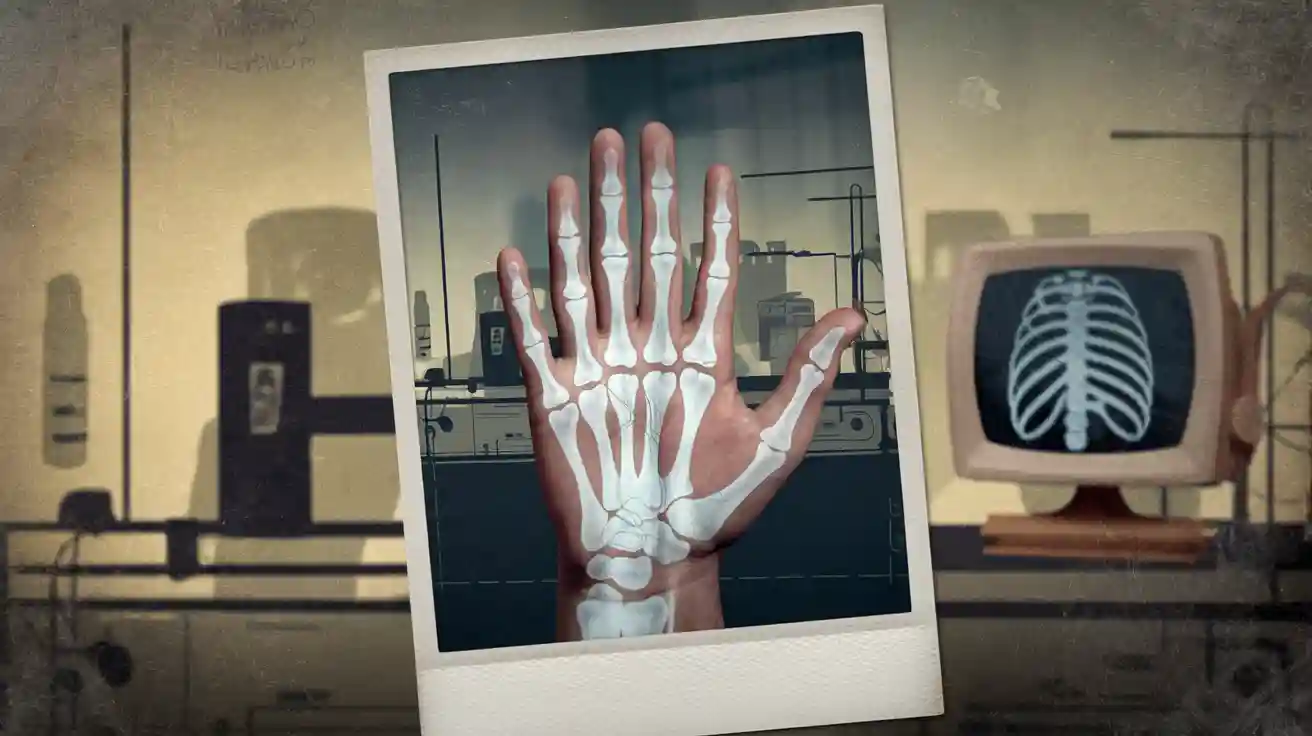

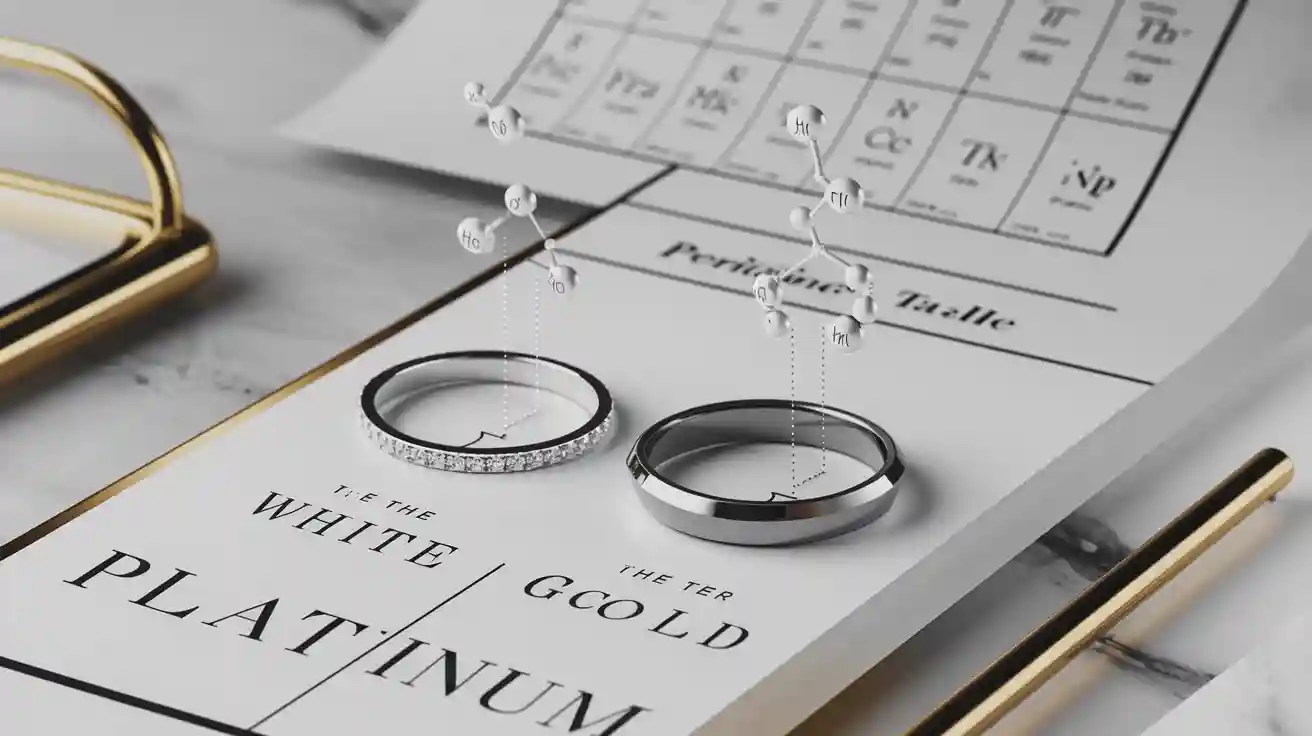
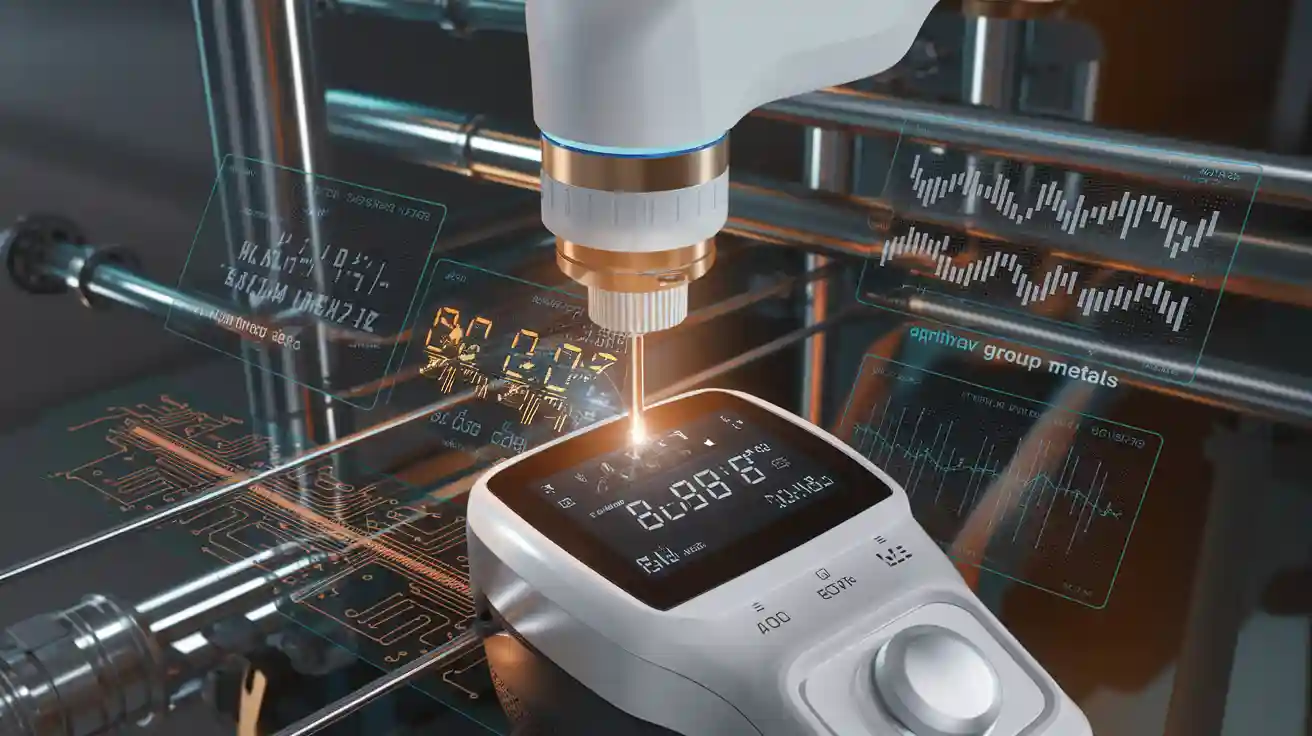
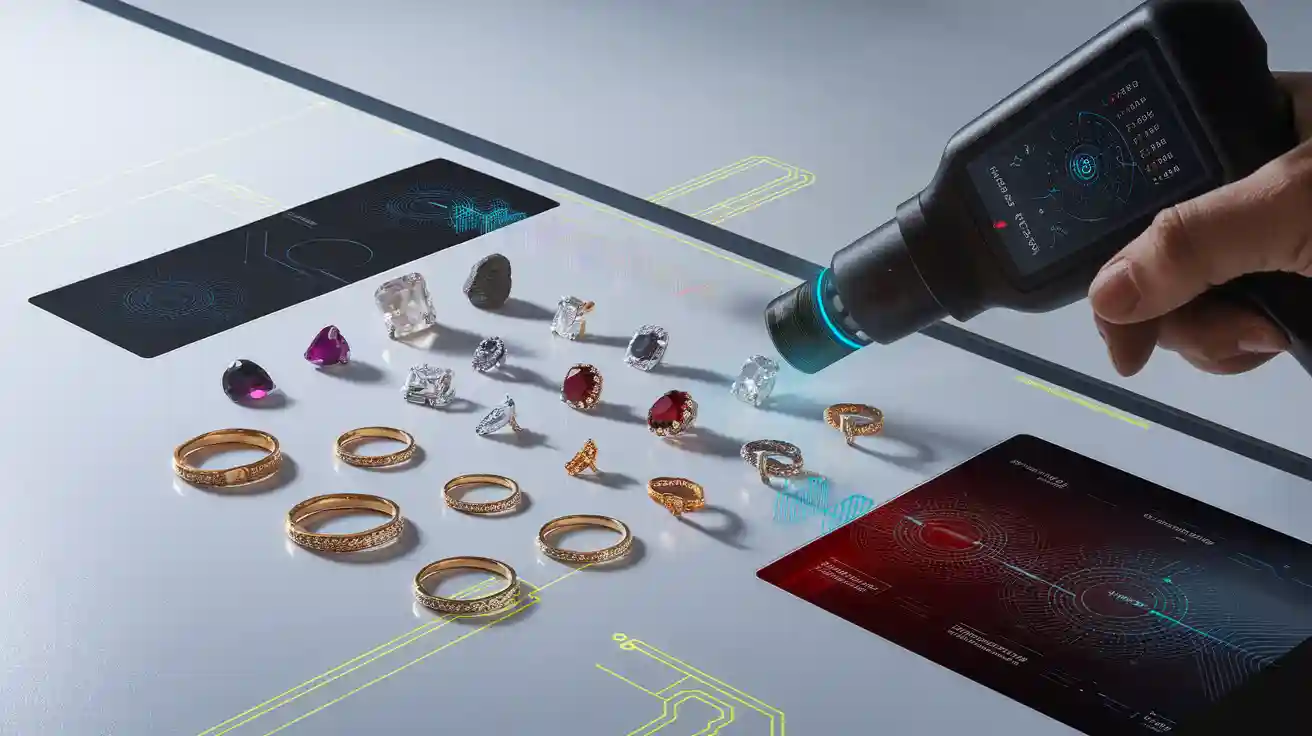

WhatsApp
Отсканируйте QR-код, чтобы начать чат с нами в WhatsApp.